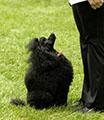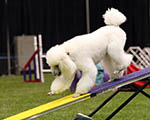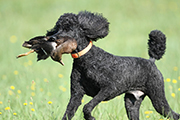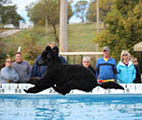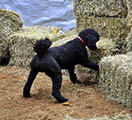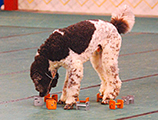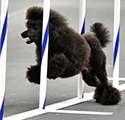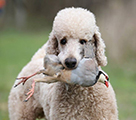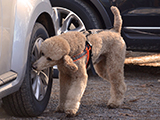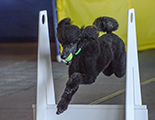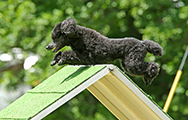
Dedicated to the Health, Education, and Performance of Poodles

Dedicated to the Health, Education, and Performance of Poodles
In order to obtain a Canine Health Information Center (CHIC) number, the Miniature Poodle must have completed testing and be registered with the Orthopedic Foundation for Animals (OFA) in the following areas:
The above tests are considered the minimum testing required for Miniature Poodles that will be used for breeding. Please note that designation with a CHIC number does not show that the dog actually passed the testing, only that the tests were administered.
To check the testing that has been done on a dog, you will need either the dog’s OFA number, the CHIC number, the registration number, or the registered name of the dog. To check the dog’s testing status, go to: https://www.ofa.org/advanced-search.
Many breeders will perform additional testing on their breeding stock. All testing is valuable and gives information regarding the breeder’s interest in the future of his/her breeding program. Using the tools that are currently available will allow the breeder to successfully use the entire gene pool in combinations that provide for a healthy future of the breed.
Also, there is a true difference in types of testing. Very few of our available tests measure genotype (actual DNA sequence of a gene). Most of our tests measure phenotype (a physical evaluation is used to measure the health of an individual in the hope of providing information about genotype). For a variety of reasons, phenotypic testing provides less reliable information about the genes a given dog might pass on to offspring. For a full explanation of the interpretation and use of phenotype testing, see the article found on the Tufts web site: https://www.vin.com/apputil/content/defaultadv1.aspx?meta=Generic&pId=11165&id=3848681
Poodles may have eye abnormalities which include progressive retinal atrophy (PRA), optic nerve hypoplasia, distichiasis, micropapilla, and microphthalmia. PRA is considered hereditary, and some other eye abnormalities are presumed to be hereditary. Many of these abnormalities lead to blindness, although some can be corrected with surgery. For more information see: https://www.ofa.org/diseases/eye-certification/eye-disease-glossary.
The Companion Animal Eye Registry (CAER) exam is an eye screen performed by a board certified veterinary ophthalmologist.
The CAER eye exam is performed after drops are placed in the eyes to dilate the pupils. The exam is not comprehensive, but rather intended to detect a number of eye defects presumed to be hereditary. If a serious ocular health problem such as glaucoma is suspected, the examiner will recommend a more comprehensive examination. The diagnoses obtained during the exam refer only to the observable phenotype (clinical appearance) of an animal. Thus it is possible for a clinically normal animal (normal phenotype) to have a genetic abnormality (abnormal genotype) that may result in a clinically detectable eye disorder later in life. For this reason it is important to repeat CAER exams on a regular schedule (yearly is recommended) for breeding animals, even after they are no longer being bred.
The CAER eye screen may be done at eight weeks.
The CAER eye screen is done by a Board Certified ophthalmologist at his office or at an eye clinic held in your area sponsored by a breed club.
Poodles may have eye abnormalities which include progressive retinal atrophy (PRA), optic nerve hypoplasia, distichiasis, micropapilla, and microphthalmia. PRA is considered hereditary, and some other eye abnormalities are presumed to be hereditary. Many of these abnormalities lead to blindness, although some can be corrected with surgery. For more information see: https://www.ofa.org/diseases/eye-certification/eye-disease-glossary.
The prcd-PRA test is done on a small sample of blood, or from a cheek swab. The test analyzes the specific DNA mutation causing prcd-PRA, the most common form of PRA. The test detects the mutant gene copy and the normal gene copy. The result of the test is a genotype and allows separation of dogs into three groups: normal/clear (homozygous normal), carrier (heterozygous) and affected (homozygous mutant). Affected or carrier status must be bred only with normal/clear to produce non-affected offspring. For more information, go to OptiGen’s website at http://www.optigen.com/opt9_test_pra_poodle.html. Although the predominant form of PRA in Poodles is prcd-PRA, another form of PRA occurs at much lower frequencies. Information on rcd4-PRA can be found at http://vipoodle.org/health_testing_items/eyes-rcd4-pra/
Various labs have collection protocol that should be followed for that lab.
DNA tests can be done as soon as the lab will accept using their protocol. Some lab will accept dew claws or docked tails. Cheek swabs may be obtained as soon as the risk of contamination from other nursing puppies can be alleviated.
We recommend that owners/breeders use laboratories to submit testing for prcd-PRA that are approved by OFA and to record their results with OFA. A list of those labs may be found https://www.ofa.org/dna-test-labs
This is a genotype exam.
Hip dysplasia is an inherited polygenetic disease that manifests itself in a malformation of the hip joint in which the ball and socket do not properly fit together. Mildly dysplastic dogs may not exhibit any outward signs. Moderate to severe cases may exhibit rear-end lameness and/or discomfort when getting up. Arthritis often occurs over time from wearing on the hip joint. Young dogs, five to ten months, may be affected, and older dogs may develop chronic degenerative joint disease. For more information see: https://www.ofa.org/diseases/hip-dysplasia.
X-ray.
At 24+ months for OFA hip certification, at 16+ weeks for PennHIP scores (although a more accurate score may be obtained at six months, or even twelve months).
Many veterinarians are experienced in x-raying dogs’ hips. These films are sent to the OFA registry for a reading. Only PennHIP certified orthopedic and radiological specialists can do the PennHIP films; however, all PennHIP results can be sent to, and certified by, OFA.
The patella, or kneecap, is part of the stifle joint (knee). When the kneecap luxates, the kneecap slips, or pops, out of joint either to the inside or to the outside of the knee. One or both knees may be affected. Patellar luxation is often a hereditary condition although it can also be caused by an injury. Surgery may be required to fix this problem. Patellar luxation may be evident as soon as the puppy begins to walk. Other forms manifest as late as eight years old and may vary in severity. When the kneecap has slipped out of place, the dog will often carry its leg with the knee joint bent and the foot turned inward. For more information on patellar luxation, see: https://www.ofa.org/diseases/other-diseases/patellar-luxation.
Palpation.
At 12+ months of age for OFA certification.
Your local veterinarian or 0rthopedic specialist can do this examination and results should be certified by OFA. Orthopedic specialists (Diplomates) are certified by the American College of Veterinary Surgeons. The OFA recommendation is for all phenotype testing to be done by a specialist, if possible. There are just over 100 of these specialists in the USA. Many states and areas do not have one available; therefore, OFA does accept examination from a veterinarian who has the “advanced training necessary to perform an accurate diagnosis.”
The most common cause of primary hypothyroidism (underactive thyroid) in dogs is autoimmune thyroiditis. Autoimmune thyroiditis is a heritable disease that is seen in all three varieties of Poodles, but is more common in Standard Poodles. This disorder may affect a dog at any age, but clinical signs are often seen in dogs between two to five years of age. Hypothyroidism is not generally a life-threatening disease, but it is a permanent condition. When diagnosed, the traditional, effective treatment is a daily, or twice daily, dose of a thyroid hormone replacement (synthetic L-thyroxine). Dogs with this condition should not be bred. Breeding animals should be tested yearly for the first four years and, after that, every other year. For more information, see: https://www.ofa.org/diseases/other-diseases/hypothyroidism
Blood sample.
Subsequent to sexual maturity in males, and between heat cycles (twelve to sixteen weeks following onset of heat) in females.
Thyroid testing is difficult to do correctly so only a few laboratories are recognized by the OFA. For a list of recognized laboratories, go to the OFA website at https://www.ofa.org/diseases/other-diseases/hypothyroidism/thyroid-labs.
A disorder of the cartilage and bone characterized by stunted growth and abnormal movement. Most affected puppies are so severely disabled that they must be euthanized. The disorder first becomes apparent at 3 weeks of age when affected puppies show signs of stunted growth and abnormal movement. Affected puppies go on to develop enlarged and stiffened joints, abducted hind limbs, dorsoventral flattening of the rib cage, shortened and bent long bones, undershot jaws, and elongated and misshapen paws that resemble clubfoot. Some affected puppies do survive and stiffness diminishes with age, but mobility remains restricted and arthritis often develops. This is caused by an autosomal recessive mutation in the SLC13A1 Sulfate Transporter gene. Individuals who carry two mutant copies of the SLC13A1 gene are affected. Individuals who carry one mutant and one normal copy of the gene or who carry two normal copies of the gene are unaffected. Sire and dam must each carry at least one mutant copy of the gene to have affected offspring. For more information see: http://www.optigen.com/opt9_oc_minpoodles.html
A DNA test for the mutation causing Osteochondrodysplasia.. The test detects the mutant gene copy and the normal gene copy. The result of the test is a genotype and allows separation of dogs into three groups: normal, or clear (homozygous normal), carrier (heterozygous) and affected (homozygous mutant). DNA for the test is obtained from a cheek swab.
Miniature Poodles should be tested for the SLC13A1 Osteochondrodysplasia mutation before breeding. Every breeding should include at least one parent that is normal/clear by DNA testing for Osteochondrodysplasia. Any other combination has an unacceptably high risk of producing affected puppies.
Testing for the Osteochondrodysplasia mutation is available through several approved labs.
Poodles may have eye abnormalities which include progressive retinal atrophy (PRA), optic nerve hypoplasia, distichiasis, micropapilla, and microphthalmia. PRA is considered hereditary, and some other eye abnormalities are presumed to be hereditary. Many of these abnormalities lead to blindness, although some can be corrected with surgery. For more information see: https://www.ofa.org/diseases/eye-certification/eye-disease-glossary.
The rcd4-PRA test is done on a small sample of blood, or from a cheek swab. The test analyzes the specific DNA mutation causing rcd4-PRA. The test detects the mutant gene copy and the normal gene copy. The result of the test is a genotype and allows separation of dogs into three groups: normal/clear (homozygous normal), carrier (heterozygous) and affected (homozygous mutant). Affected or carrier status must be bred only with normal/clear to produce non-affected offspring. For more information, go to http://www.optigen.com/opt9_rcd4PRA.html.
Another form of PRA occurs at much higher frequencies. Information on prcd-PRA can be found at http://vipoodle.org/chic_testing_items/eyes-prcd-pra/
Various labs have collection protocol that should be followed for that lab.
DNA tests can be done as soon as the lab will accept using their protocol. Some lab will accept dew claws or docked tails. Cheek swabs may be obtained as soon as the risk of contamination from other nursing puppies can be alleviated.
We recommend that owners/breeders use laboratories to submit testing for rcd4-PRA that are approved by OFA and to record their results with OFA. A list of those labs may be found https://www.ofa.org/dna-test-labs.
This is a genotype exam.
Elbow dysplasia is a general term used to identify an inherited polygenic disease in the elbows of dogs. Young dogs, four to ten months of age, may begin to show lameness. The elbows may seem swollen and are held outward from the chest. For more information, see: https://www.ofa.org/diseases/elbow-dysplasia.
X-ray.
At 24+ months for OFA certification.
Many veterinarians are experienced in x-raying dogs’ elbows. These films are sent to the OFA registry for a reading.
Legg-Calve-Perthes disease (LCP) is a disorder of hip joint conformation. It is most often seen in the miniature and toy breeds between the ages of four months to a year. OFA evaluates x-rays and certifies whether a dog is clear of LCP. If a dog’s hips are evaluated as normal for hip dysplasia, the dog is also considered normal for LCP and the LCP number is issued free upon making application. For more information see: https://www.ofa.org/diseases/other-diseases/legg-calve-perthes.
X-ray.
12+ months for OFA certification.
Many veterinarians are experienced in x-raying dogs’ hips. These films are sent to the OFA registry for a reading.
Von Willebrand’s disease is an inherited bleeding disorder. In vWD, bleeding is caused by the absence of the von Willebrand’s factor which is needed in the early stages of clotting. For more information see: http://www.vetgen.com/canine-vwd1.html.
DNA test using a cheek swab.
Anytime after birth. If both parents are certified clear and if the parents are certified by the lab as being the parents of the litter, then a “certificate by pedigree” may be issued to the offspring.
Test kits are available from VetGen. See the contact information for VetGen in the address section.
Most Miniature breeders do not perform the von Willebrand’s disease testing. However, with continued combination breeding of Miniatures and Standards, the introduction of some Miniature problems into Standard lines and Standard problems into Miniature lines makes this test worth mentioning. Though rare, instances of this disease appearing in Miniatures have been reported.
The information contained in these documents is current at the time of this writing and is accurate to the best of VIP’s knowledge.
